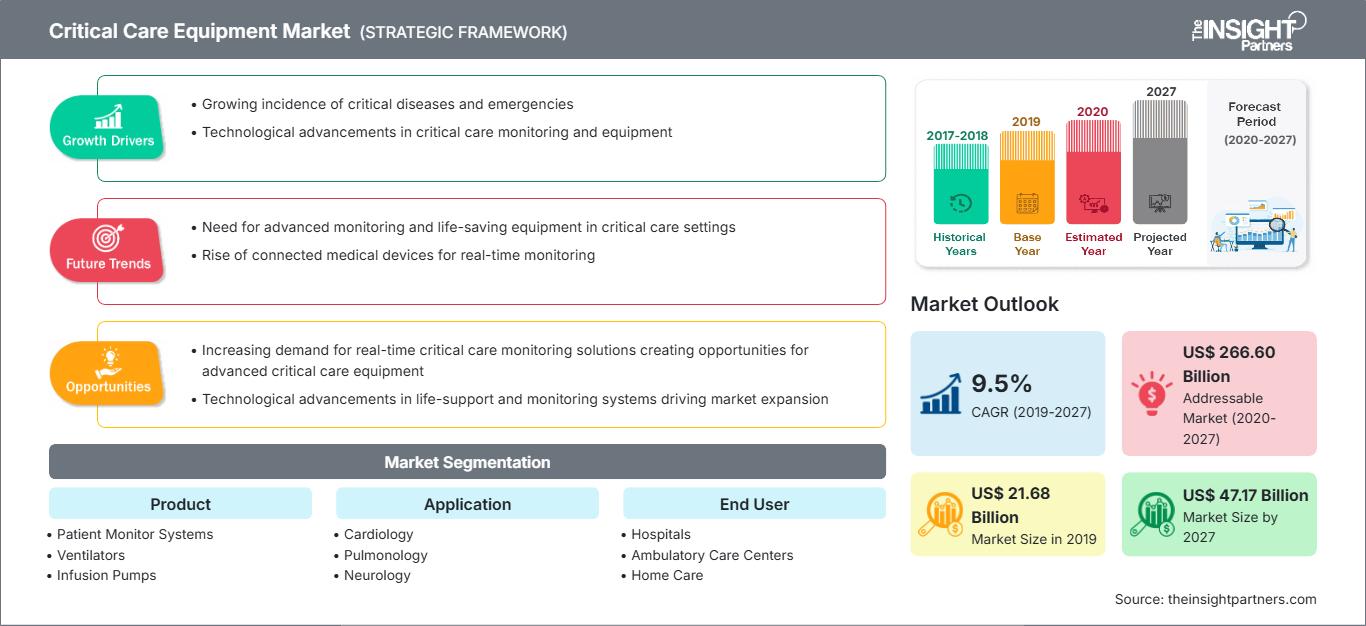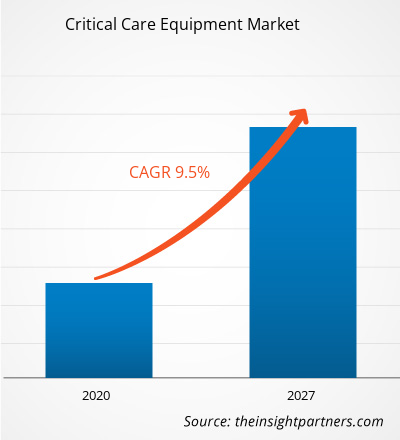Il mercato delle apparecchiature per la terapia intensiva è stato valutato a 21.682,65 milioni di dollari nel 2019 e si prevede che raggiungerà i 47.171,42 milioni di dollari entro il 2027; si prevede una crescita a un CAGR del 9,5% tra il 2020 e il 2027.
Un letto di terapia intensiva è attrezzato e dotato di personale in grado di fornire assistenza di livello intensivo e di fornire ventilazione meccanica insieme al monitoraggio invasivo. Secondo il National Center for Biotechnology Information, a maggio 2020, mentre il Canada era al culmine dell'epidemia di COVID-19, il fabbisogno di letti di terapia intensiva ha superato significativamente il fabbisogno, nonostante il 40% di autoisolamento. Il numero di letti di terapia intensiva esistenti in ciascuna regione variava da 0,63 a 1,85 ogni 10.000 persone. Supponendo un tasso di occupazione attuale stimato dell'80%, i posti letto in terapia intensiva disponibili per i pazienti COVID-19 varierebbero a livello regionale da 0,13 a 0,37 ogni 10.000 persone.
I pazienti con l'infezione trascorrono in media 15 giorni in terapia intensiva. Secondo la Società Europea di Anestesiologia, il numero di posti letto in terapia intensiva in Italia continua a crescere. In Lombardia, prima della diffusione del coronavirus, c'erano 140 posti letto in terapia intensiva privata e 500 posti letto in terapia intensiva pubblica, che sono aumentati a oltre 900 entro la fine di marzo 2020.
Personalizza questo rapporto in base alle tue esigenze
Potrai personalizzare gratuitamente qualsiasi rapporto, comprese parti di questo rapporto, o analisi a livello di paese, pacchetto dati Excel, oltre a usufruire di grandi offerte e sconti per start-up e università
Mercato delle apparecchiature per terapia intensiva: Approfondimenti strategici

- Ottieni le principali tendenze chiave del mercato di questo rapporto.Questo campione GRATUITO includerà l'analisi dei dati, che vanno dalle tendenze di mercato alle stime e alle previsioni.
Approfondimenti di mercato: il crescente numero di posti letto in terapia intensiva nei paesi con elevata prevalenza di COVID-19 guiderà la crescita del mercato
Potrai personalizzare gratuitamente qualsiasi rapporto, comprese parti di questo rapporto, o analisi a livello di paese, pacchetto dati Excel, oltre a usufruire di grandi offerte e sconti per start-up e università
Mercato delle apparecchiature per terapia intensiva: Approfondimenti strategici

- Ottieni le principali tendenze chiave del mercato di questo rapporto.Questo campione GRATUITO includerà l'analisi dei dati, che vanno dalle tendenze di mercato alle stime e alle previsioni.
L'11 marzo 2020, l'Organizzazione Mondiale della Sanità ha dichiarato il COVID-19 una pandemia globale. Questa nuova malattia è caratterizzata da un numero inferiore di casi iniziali, seguito da un'esplosione di infezioni in diversi paesi. Nonostante l'attuazione di lockdown per ridurre la diffusione del COVID-19, i sistemi sanitari di diversi paesi sono stati sopraffatti dalla domanda di attrezzature, come letti per terapia intensiva e attrezzature di supporto per il trattamento di casi gravi.
Approfondimenti sui prodotti
In termini di prodotto, il segmento dei sistemi di monitoraggio paziente ha detenuto la quota maggiore del mercato nel 2019 e si prevede che continuerà a essere un azionista di riferimento durante il periodo di previsione. Tuttavia, si prevede che il segmento dei ventilatori registrerà un CAGR più elevato sul mercato durante il periodo di previsione.
Approfondimenti sulle applicazioni
In base all'applicazione, il mercato globale delle apparecchiature per la terapia intensiva è segmentato in cardiologia, pneumologia, neurologia, ortopedia e altri. Il segmento della cardiologia ha detenuto la quota di mercato maggiore nel 2019 e si prevede che il segmento della pneumologia registrerà il CAGR più elevato durante il periodo di previsione. La terapia intensiva cardiovascolare è la gestione sistemica dei pazienti con gravi malattie cardiovascolari (MCV), tra cui malattie vascolari e cardiache. Le MCV sono tra le principali cause di morte in tutto il mondo. Ad esempio, secondo l'Organizzazione Mondiale della Sanità, nel 2016 si stima che 17,9 milioni di persone siano morte per MCV, rappresentando il 31% dei decessi a livello mondiale. Analogamente, secondo i Centers for Diseases Control and Prevention, circa 655.000 americani muoiono ogni anno per malattie cardiache. Per prevenire i decessi dovuti a malattie cardiovascolari, negli ospedali generali è disponibile un'unità di terapia intensiva per pazienti con malattie cardiovascolari gravi, ovvero l'unità di terapia intensiva cardiovascolare (UTIC). Gli sviluppi tecnologici della cardiologia clinica, come le procedure e i dispositivi interventistici intracoronarici e il monitoraggio emodinamico invasivo, rappresentano le principali evoluzioni della terapia intensiva per le malattie cardiovascolari. Di conseguenza, il numero di pazienti con malattie cardiovascolari gravi ricoverati in UTIC cresce ogni anno. I pazienti in UTIC presentano numerose complicazioni, come insufficienza respiratoria e insufficienza renale. Pertanto, è necessario personale medico qualificato per praticare la terapia intensiva sistemica.
Si prevede che le collaborazioni e le partnership tecnologiche tra gli operatori del mercato delle apparecchiature per la terapia intensiva, volte a colmare il divario tra domanda e offerta, svolgeranno un ruolo significativo nella crescita del mercato durante il periodo di previsione.
Approfondimenti regionali sul mercato delle apparecchiature per terapia intensiva
Le tendenze regionali e i fattori che influenzano il mercato delle apparecchiature per terapia intensiva durante il periodo di previsione sono stati ampiamente spiegati dagli analisti di The Insight Partners. Questa sezione illustra anche i segmenti e la geografia del mercato delle apparecchiature per terapia intensiva in Nord America, Europa, Asia-Pacifico, Medio Oriente e Africa, America Meridionale e Centrale.
Ambito del rapporto sul mercato delle apparecchiature per terapia intensiva
| Attributo del rapporto | Dettagli |
|---|---|
| Dimensioni del mercato in 2019 | US$ 21.68 Billion |
| Dimensioni del mercato per 2027 | US$ 47.17 Billion |
| CAGR globale (2019 - 2027) | 9.5% |
| Dati storici | 2017-2018 |
| Periodo di previsione | 2020-2027 |
| Segmenti coperti |
By Prodotto
|
| Regioni e paesi coperti | Nord America
|
| Leader di mercato e profili aziendali chiave |
|
Densità degli operatori del mercato delle apparecchiature per terapia intensiva: comprendere il suo impatto sulle dinamiche aziendali
Il mercato delle apparecchiature per la terapia intensiva è in rapida crescita, trainato dalla crescente domanda degli utenti finali, dovuta a fattori quali l'evoluzione delle preferenze dei consumatori, i progressi tecnologici e una maggiore consapevolezza dei vantaggi dei prodotti. Con l'aumento della domanda, le aziende stanno ampliando la propria offerta, innovando per soddisfare le esigenze dei consumatori e sfruttando le tendenze emergenti, alimentando ulteriormente la crescita del mercato.

- Ottieni il Mercato delle apparecchiature per terapia intensiva Panoramica dei principali attori chiave
- Sistemi di monitoraggio paziente
- Ventilatori
- Ventilatori invasivi
- Ventilatori non invasivi
- Pompe per infusione
- Altro
Per Applicazione
- Cardiologia
- Pneumologia
- Neurologia
- Ortopedia
- Altro
Per utente finale
- Ospedali
- Centri di cura ambulatoriali
- Assistenza domiciliare
- Altro
Per Geografia
- Nord America
- Stati Uniti
- Canada
- Messico
- Europa
- Francia
- Germania
- Italia
- Regno Unito
- Russia
- Asia Pacifico (APAC)
- Cina
- India
- Sud Corea
- Giappone
- Australia
- Medio Oriente e Stati Uniti. Africa (MEA)
- Sudafrica
- Arabia Saudita
- Emirati Arabi Uniti
- America meridionale e centrale (SCAM)
- Brasile
- Argentina
Profili aziendali
- General Electric Company
- Medtronic
- B. Braun Melsungen AG
- Baxter International Inc.
- Koninklijke Philips NV
- Getinge AB
- Hamilton Medical
- Löwenstein Medical UK Ltd.
- Dragerwerk AG & Co. KGaA
- Nihon Kohden Corporation
- Fisher & Paykel Healthcare Limited.
- Shenzhen Mindray Biomedical Electronics Co., Ltd.
- BPL
- Trivitron Healthcare
- SKANRAY TECHNOLOGIES PVT LTD
- Asahi Kasei Corporation
- Analisi storica (2 anni), anno base, previsione (7 anni) con CAGR
- Analisi PEST e SWOT
- Valore/volume delle dimensioni del mercato - Globale, Regionale, Nazionale
- Industria e panorama competitivo
- Set di dati Excel
Report recenti
Rapporti correlati
Testimonianze
Motivo dell'acquisto
- Processo decisionale informato
- Comprensione delle dinamiche di mercato
- Analisi competitiva
- Analisi dei clienti
- Previsioni di mercato
- Mitigazione del rischio
- Pianificazione strategica
- Giustificazione degli investimenti
- Identificazione dei mercati emergenti
- Miglioramento delle strategie di marketing
- Aumento dell'efficienza operativa
- Allineamento alle tendenze normative




















 Ottieni un campione gratuito per - Mercato delle apparecchiature per terapia intensiva
Ottieni un campione gratuito per - Mercato delle apparecchiature per terapia intensiva